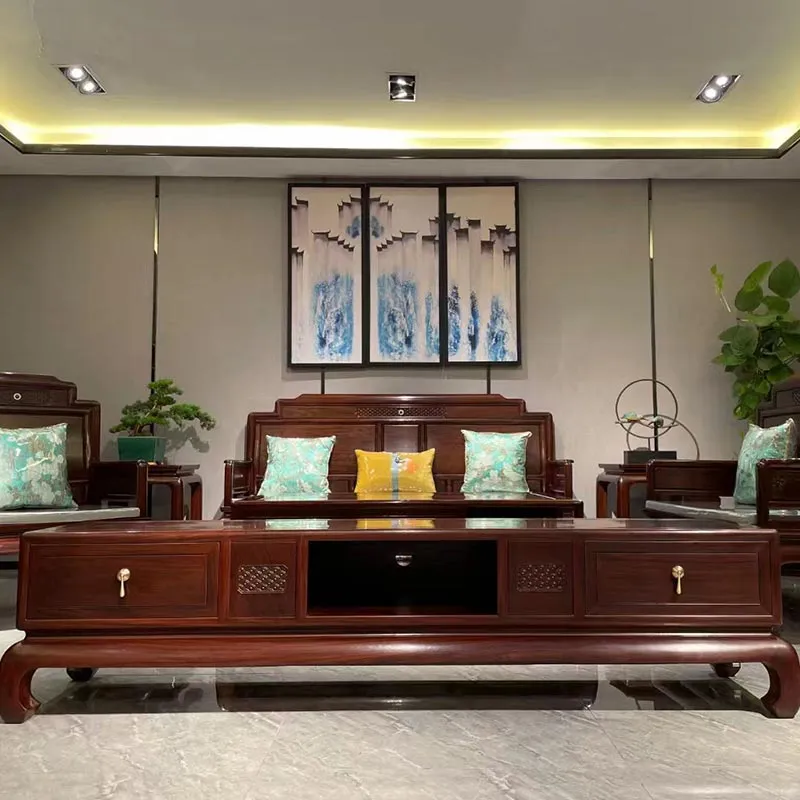Choosing the Right Chinese Restaurant Furniture: A Guide to Style, Functionality, and Comfort
2024-11-28
When designing or outfitting a Chinese restaurant, furniture plays a crucial role in creating the right atmosphere, enhancing the dining experience, and maintaining the functionality needed for busy service. The right mix of traditional and contemporary furniture can help reflect the restaurant's aesthetic, whether you're aiming for an authentic Chinese look or a more modern fusion style. In this blog, we’ll explore the different types of furniture commonly used in Chinese restaurants, the materials that work best, and how to strike the right balance between comfort, style, and practicality.
1. Types of Chinese Restaurant Furniture
The furniture in a Chinese restaurant should cater to both the dining experience and the operational needs of the restaurant. Key furniture pieces include:
a. Dining Tables
- Round Tables: In Chinese dining culture, round tables are preferred because they promote shared dining, allowing dishes to be placed in the center for all to enjoy. These tables often come with a lazy Susan, a rotating tray that makes it easier for diners to reach food.
- Size Options: Depending on the restaurant's capacity, round tables typically range from 4 to 12 seats.
- Materials: Wood (often lacquered or with traditional Chinese motifs), metal, or glass are common materials. Some upscale restaurants may use marble or granite tabletops for a more luxurious feel.
- Square or Rectangular Tables: While round tables are more traditional, square or rectangular tables are sometimes used in more casual dining setups or smaller spaces. They can be arranged in different configurations to maximize seating capacity.
b. Chairs
- Wooden Chairs: Traditional Chinese wooden chairs are often made from dark woods like rosewood or teak, which offer durability and an elegant, refined look. Chairs may feature intricate carvings, often depicting dragons, phoenixes, or floral patterns, which are common in Chinese design.
- Upholstered Chairs: For added comfort, upholstered chairs with padded seats and backs are a good option. These can be made with luxury fabrics like velvet, silk, or leather to create a more upscale atmosphere.
- Armchairs: These can be used for VIP or more intimate seating arrangements, offering added comfort and a sense of exclusivity.
c. Booth Seating
- Booths are becoming more popular in Chinese restaurants, especially those catering to families or groups. Booths provide a more private, cozy setting and can accommodate larger groups, making them ideal for family-style meals.
- Materials: Booths may feature plush cushions, vinyl, or leather upholstery. The design can range from traditional to contemporary, depending on the theme of the restaurant.
d. Barstools and Counter Seating
- For Chinese restaurants with a bar area or dim sum counters, barstools or high chairs are often used. These stools are typically made from wood or metal, and their height is ideal for counter dining.
- Modern restaurants may choose stools with a minimalist or industrial design for a more contemporary ambiance.
e. Serving and Display Furniture
- Buffets & Serving Stations: In restaurants offering dim sum, hot pot, or buffet-style dining, serving stations or carts are an essential piece of furniture. These may be movable or fixed and are often designed to match the restaurant’s overall décor.
- Display Cabinets: For showcasing special teas, fine chinaware, or decorative items, glass-fronted cabinets or display shelves are commonly used in Chinese restaurants.
- Tea Trolley or Cart: A traditional piece in many Chinese restaurants, a tea cart is used to serve tea to guests in an elegant, ceremonial fashion. The cart often features intricate carvings or decorative elements in line with the restaurant's aesthetic.

2. Materials Used in Chinese Restaurant Furniture
The choice of materials for Chinese restaurant furniture impacts not only the look and feel of the space but also its functionality and longevity. Here are some popular materials used:
a. Wood
- Wood is an essential element in traditional Chinese furniture design. It adds a sense of warmth, elegance, and authenticity.
- Hardwoods like mahogany, rosewood, teak, and pine are popular choices for tables, chairs, and other furniture due to their strength and longevity.
- Lacquered Finishes: Many Chinese restaurant tables and chairs feature lacquered finishes, giving them a shiny, smooth surface that adds sophistication. The lacquered surface is also easy to clean and resistant to moisture.
b. Metal
- Stainless Steel: For a more contemporary look, metal elements like stainless steel are used in modern Chinese restaurant furniture, especially for chairs, stools, and tables with minimalist designs.
- Iron and Brass: These materials are used for decorative accents or in more ornate furniture designs, often featuring Chinese motifs or elements like scrolls, dragons, and phoenixes.
c. Glass
- Glass Tabletops: For a more contemporary or fusion style, tempered glass tops are often used on dining tables. Glass tabletops can help achieve a clean, modern look while complementing wooden or metal bases.
- Glass Display Cabinets: Used to display fine porcelain, tea sets, or other decorative items, glass-fronted cabinets are an attractive addition to Chinese restaurants.
d. Upholstery
- Silk and Velvet: Upholstered chairs, booths, and stools in Chinese restaurants are often made from silk, velvet, or other luxurious fabrics that add richness to the dining experience. These fabrics can be embroidered with traditional patterns, adding an extra layer of elegance.
- Leather and Faux Leather: Leather is a durable, easy-to-clean option that is often used in high-end Chinese restaurants, especially for booths and armchairs.
3. Style and Ambiance
The furniture you choose will heavily influence the overall ambiance of your Chinese restaurant. Whether you're going for a traditional, elegant setting or a modern, casual dining atmosphere, here’s how different styles can complement your restaurant’s theme:
- Traditional Style: Opt for wooden furniture with intricate carvings, red and gold color schemes, and Chinese motifs like dragons, bamboo, and lotus flowers. Adding decorative elements such as chandeliers with Chinese-style lanterns or scroll paintings can complete the look.
- Modern Fusion: For a more modern approach, you can mix sleek, minimalist furniture with traditional Chinese accents. Stainless steel or metal chairs, glass tables, and contemporary lighting can create a fresh, modern twist on traditional Chinese design.
- Contemporary Casual: If you're creating a more casual and laid-back vibe, focus on simple, durable furniture. You can use neutral colors like black, gray, or brown with clean lines and comfortable upholstery to create a relaxed atmosphere that still maintains cultural elements like wood paneling or bamboo.
4. Practical Considerations
- Durability: Chinese restaurant furniture should be durable and easy to maintain, as restaurants experience heavy foot traffic and frequent cleaning. Choose materials that are scratch-resistant, moisture-proof, and easy to wipe down.
- Comfort: Comfort is key, especially for long dining experiences. Ensure that chairs and booths have appropriate padding and ergonomic design to provide a pleasant dining experience.
- Space Efficiency: For smaller restaurants or those with tight seating arrangements, stackable chairs, foldable tables, or modular seating can maximize space and provide flexibility.
- Cost: Budget plays a big role in selecting furniture. While high-end materials like solid wood and luxury fabrics may come with a premium price, there are also cost-effective options that don’t compromise on quality and style.
Conclusion
When selecting furniture for a Chinese restaurant, it’s important to strike the right balance between aesthetics, comfort, and functionality. From traditional wooden round tables with intricate carvings to sleek, modern dining setups, the furniture you choose will set the tone for the overall dining experience. By considering the restaurant’s theme, target audience, and operational needs, you can create an inviting and comfortable atmosphere that enhances the enjoyment of your guests while also serving the practical needs of your business.


